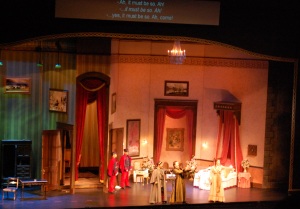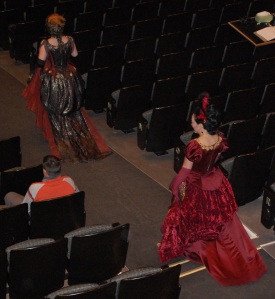The Westbury Theatre was sold out. The Arts Barns lobby was filled with a queue folding back on itself like a pack of ramen noodles. Lots of familiar faces from the Edmonton theatre scene and lots of twitter buzz reinforced what I’d heard: the opening night of the new Catalyst Theatre production of Jonathan Christenson’s Nevermore was a big deal.
Nevermore recounts the life story of Edgar Allan Poe, the American nineteenth-century writer of the creepy and suspenseful. Compared to The Soul Collector, a Christenson / Catalyst production I saw last spring, the narrative of Nevermore is direct and almost completely linear. But it’s still a supremely weird show, set in a world where nothing is normal. (Nothing is right-angled either!) It was also interesting to view this show recalling Emily Winter’s portrayal of Poe in last summer’s Fringe hit Poe and Mathews.
Most of the story is told by one of the narrators speaking directly to the audience in rhyme, while the characters in that part of the story interact physically and sing together. This works better than you might expect, conveying a literary and distanced mood but showing the affection and awkwardness among the flawed individual characters.
Scott Shpeley plays Edgar, from about age 8 to his death at 40. He does the whole show in the same odd black and white costume and makeup, but his motions and postures show obvious changes from child to adolescent and young man to older man. His appealing clear tenor voice works well for the character at all ages. As a child, he frequently looked small, fearful, and pitiable, trembling all over. In one of the glimpses of happiness, when he falls in love with his young cousin (Beth Graham), his face is illuminated by joy. And in one of the moments of anguish he lifts a tear-streaked face to the audience.
The other six actors in the ensemble play several parts each, with various additions to hair or costume. Garett Ross and Vanessa Sabourin are Edgar’s ill-fated parents (with the portrayal of his moody actress mother being especially poignant), and Gaelan Beatty and Beth Graham his siblings. Ryan Parker’s characters include a Paul-Lynde-ish portrayal of the biographer Rufus Griswold. Shannon Blanchet was Elvira Royster, a character seen as a teenager and again as a widow. One of the best portrayals was Beth Graham as Fanny Allan, Edgar’s foster mother, trying to win over the orphaned boy despite her surly merchant husband (Garett Ross) and struggling with despair.
The visual designs for this production were fascinating and spare, consistent with what I understand of the Catalyst Theatre aesthetic. Bretta Gerecke is credited as scenographer and resident designer for the company. I was intrigued and then captivated. All the costumes are black and white, twisted impressions of nineteenth century dress. Black boots are made noticeable with white accents. Rigid wires hint at hoop skirts and frock coats. Harsh monochrome lights turn costume elements reddish or bluish. Hats and hairdos are odd and extreme, from punkish spikes to one of the women’s updos looking very much like a stalk of Brussels sprouts. Human and non-human characters with long mis-shapen claw-hands reminded me of similar imagery in The Soul Collector. I loved the rhomboid oversized notebooks and asymmetric undersized trunks. Many characters adopted odd hand and body positions like twisted sculptures.
Nevermore is playing at the Westbury Theatre until the afternoon of Sunday March 2nd. If you like going to weird theatre, unconventional musicals, or shows that everyone in Edmonton will be referring to for years, then you should make time in your schedule for this. You can get tickets at Tix on the Square. There are also some $10 youth tickets available at the door for each performance.





